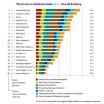(Press-News.org) Scientists believe that fish ear bones and their distinctive growth rings can offer clues to the likely impacts of climate change in aquatic environments.
The earbones, or 'otoliths', help fish to detect movement and to orient themselves in the water. Otoliths set down annual growth rings that can be measured and counted to estimate the age and growth rates of fish.
"Otoliths can form the basis of new techniques for modelling fish growth, productivity and distribution in future environments," said Dr John Morrongiello of CSIRO's Wealth from Oceans Flagship, lead author of a paper published online in Nature Climate Change today.
"They are widely used to support fishery stock assessments, and are beginning to be used to measure and predict ecological responses to ocean warming and climate change.
"Millions of otoliths are archived in research laboratories and museums worldwide, and many fish species live for decades and some, such as orange roughy, live for up to 150 years.
"Their otoliths record variations in growth rates that reflect environmental conditions. Longer-lived fish and older samples take us back as far as the 1800s."
The paper, co-authored by Dr Ron Thresher and Dr David Smith of CSIRO, builds on earlier research by Dr Thresher that identified the potential of using fish 'hard parts', (such as otoliths), and deep ocean corals to understand environmental change. It outlines a framework in which Australian research institutions can analyse hard parts and assess past and future impacts on a range of species.
In the next research phase, scientists at CSIRO, the Australian Institute of Marine Science and the University of Adelaide will study selected species of commercial interest, including tiger flathead, black bream, blue gropers, barramundi and tropical snappers.
"We will use otoliths to investigate the environmental drivers of fish growth for many species around Australia," Dr Morrongiello said.
"This will allow us to generate a continental-scale evaluation of climate change impacts on Australia's fishes and help to guide the conservation and management of our aquatic environments into the future."
Dr Thresher said there had already been extensive use of hard part archives from corals to reflect on climate variability, such as El Niño events, and to reconstruct environmental histories.
"Any change identified in growth and age maturity, especially of commercially-important species, clearly has implications for forecasting future stock states and the sustainable management of fisheries," Dr Thresher said.
"A better ability to predict such change will greatly enhance our ability to forecast, manage and adapt to the impacts of climate change in marine and freshwater systems."
INFORMATION:
Fish ear bones point to climate impacts
2012-11-28
ELSE PRESS RELEASES FROM THIS DATE:
4 is the 'magic' number
2012-11-28
According to psychological lore, when it comes to items of information the mind can cope with before confusion sets in, the "magic" number is seven.
But a new analysis by a leading Australian professor of psychiatry challenges this long-held view, suggesting the number might actually be four.
In 1956, American psychologist George Miller published a paper in the influential journal Psychological Review arguing the mind could cope with a maximum of only seven chunks of information.
The paper, "The Magical Number Seven, Plus or Minus Two. Some Limits on Our Capacity ...
Biggest black hole blast discovered
2012-11-28
Quasars are the intensely luminous centres of distant galaxies that are powered by huge black holes. This new study has looked at one of these energetic objects – known as SDSS J1106+1939 – in great detail, using the X-shooter instrument on ESO's VLT at the Paranal Observatory in Chile [1]. Although black holes are noted for pulling material in, most quasars also accelerate some of the material around them and eject it at high speed.
"We have discovered the most energetic quasar outflow known to date. The rate that energy is carried away by this huge mass of material ...
Potentially toxic flame retardants found in many US couches
2012-11-28
DURHAM, N.C. -- More than half of all couches tested in a Duke University-led study contained potentially toxic or untested chemical flame retardants that may pose risks to human health.
Among the chemicals detected was "Tris," a chlorinated flame retardant that is considered a probable human carcinogen based on animal studies.
"Tris was phased out from use in baby pajamas back in 1977 because of its health risks, but it still showed up in 41 percent of the couch foam samples we tested," said Heather Stapleton, associate professor of environmental chemistry at ...
80 percent of parents interested in genetic risk assessment for siblings of children with autism
2012-11-28
Cambridge, MA (November 28, 2012)--The vast majority (80 percent) of parents with at least one child with Autism Spectrum Disorder (ASD) would pursue genetic testing if a test were available that could identify risk in a younger sibling, citing the desire for earlier identification of children at risk, earlier evaluation and intervention, closer monitoring and lessened anxiety. The findings were reported in "Parental Interest in a Genetic Risk Assessment Test for Autism Spectrum Disorders," a survey published online today in the journal Clinical Pediatrics.
The survey ...
WSU researchers use 3-D printer to make parts from moon rock
2012-11-28
PULLMAN, Wash. - Imagine landing on the moon or Mars, putting rocks through a 3-D printer and making something useful – like a needed wrench or replacement part.
"It sounds like science fiction, but now it's really possible," says Amit Bandyopadhyay, professor in the School of Mechanical and Materials Engineering at Washington State University.
Bandyopadhyay and a group of colleagues recently published a paper in Rapid Prototyping Journal demonstrating how to print parts using materials from the moon.
Bandyopadhyay and Susmita Bose, professor in the School of Mechanical ...
Treating cocaine dependence: A promising new pharmacotherapy
2012-11-28
Philadelphia, PA, November 28, 2012 – Medication development efforts for cocaine dependence have yet to result in an FDA approved treatment. The powerful rewarding effects of cocaine, the profound disruptive impact of cocaine dependence on one's lifestyle, and the tendency of cocaine to attract people who make poor life choices and then exacerbate impulsive behavior all make cocaine a vexing clinical condition.
In this battle, many candidate pharmacotherapies have been tested, but none have succeeded sufficiently to be adopted widely. Perhaps like cancer, heart disease, ...
Brain cell transplants in early 2013
2012-11-28
As part of the European study TRANSEURO, five patients with Parkinson's disease will undergo brain cell transplants at Skåne University Hospital in Lund, Sweden, in early 2013. These are the first operations of their kind in Europe for over 10 years.
The TRANSEURO study, which in Sweden is led by Lund University, is now taking a critical approach to the viability of cell therapy as a future treatment for Parkinson's disease. Can we replace cells that die as a result of our most common neurological diseases? What are the therapies of the future for neurodegenerative diseases ...
Report finds Big Pharma is doing more for access to medicine in developing countries
2012-11-28
Amsterdam, the Netherlands: The latest Access to Medicine Index, which ranks the top 20 pharmaceutical companies on their efforts to improve access to medicine in developing countries, finds that the industry is doing more than it was two years ago, with GlaxoSmithKline still outperforming its peers, but an expanding group of leaders closing the gap.
The Index, published Wednesday, found that Johnson & Johnson was one of the most dramatic risers, climbing from the middle of the field in 9th position in the 2010 Index to 2nd this year, closely behind GlaxoSmithKline. It ...
Anthropological expertise facilitates multicultural women's health care
2012-11-28
Collaboration between medical and anthropological expertise can solve complex clinical problems in today's multicultural women's healthcare, shows Pauline Binder, a medical anthropologist, who will present her thesis on 1 December at the Faculty of Medicine, Uppsala University, Sweden.
Pauline Binder has applied in-depth medical anthropological research approaches to understand clinical problems in ways not possible using only statistics. Why pregnant Somali women have an increased risk of complications even after migration has been the starting point for her fieldwork. ...
Researchers identify ways to exploit 'cloud browsers' for large-scale, anonymous computing
2012-11-28
Researchers from North Carolina State University and the University of Oregon have found a way to exploit cloud-based Web browsers, using them to perform large-scale computing tasks anonymously. The finding has potential ramifications for the security of "cloud browser" services.
At issue are cloud browsers, which create a Web interface in the cloud so that computing is done there rather than on a user's machine. This is particularly useful for mobile devices, such as smartphones, which have limited computing power.The cloud-computing paradigm pools the computational ...



